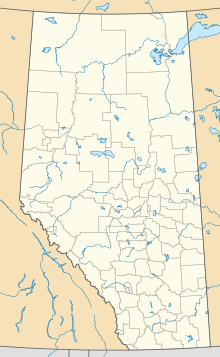Conklin | |
|---|---|
Location of Conklin in Alberta | |
| Coordinates: 55°37′52″N 111°04′44″W / 55.6311°N 111.0789°W | |
| Country | Canada |
| Province | Alberta |
| Census division | No. 16 |
| Specialized municipality | R.M. of Wood Buffalo |
| Government | |
| • Type | Unincorporated |
| • Mayor | Don Scott |
| • Governing body | Wood Buffalo Municipal Council
|
| Area (2021)[1] | |
| • Land | 16.29 km2 (6.29 sq mi) |
| Elevation | 575 m (1,886 ft) |
| Population (2021)[1] | |
| • Total | 154 |
| • Density | 9.5/km2 (25/sq mi) |
| Time zone | UTC−7 (MST) |
| • Summer (DST) | UTC−6 (MDT) |
Conklin is a hamlet in northern Alberta, Canada within the Regional Municipality (RM) of Wood Buffalo.[2] It is located on Highway 881 between Fort McMurray and Lac La Biche. It lies near the west end of Christina Lake at an elevation of 575 metres (1,886 ft), and was named for John Conklin, a railroad employee.[3]
The hamlet is located in Census Division No. 16 and in the federal riding of Fort McMurray-Athabasca.
YouTube Encyclopedic
-
1/3Views:3 807 188402742
-
Strange sounds in Conklin, Alberta Jan. 12/2012
-
If you do drugs... - Conklin Film Studio 2011
-
The Conklin Years by Rob Connelly
Transcription
History
The hamlet of Conklin was named for John Conklin, a railroad employee.[3] It was originally situated at the extreme northwestern end of Christina Lake, adjacent to its outlet at the Jackfish River. When the Alberta and Great Waterways Railway (which eventually became part of the Northern Alberta Railway and later the Athabasca Northern Railway)[4] reached Conklin in 1921, the town was relocated alongside the railway tracks.[5]
Conklin was an important centre for the local fur trade from 1940 to 1960. Mink pelts from several mink farms in the area were transferred by canoe and dogsled to the railway siding at Conklin for shipment to markets.[5]
From 1940 to 1960 there was heavy commercial fishing in Christina Lake, and a fish processing plant was located at the outlet to the Jackfish River.[5]
Conklin lies within the Athabasca Oil Sands region, and Cenovus Energy has been operating its Christina Lake project in the area since 2000. The Christina Lake project is a steam-assisted gravity drainage (SAGD) project that recovers bitumen from the McMurray Formation, which lies at a depth of 375 m (1,230 ft) at that location.[6]
Demographics
In the 2021 Census of Population conducted by Statistics Canada, Conklin had a population of 154 living in 57 of its 91 total private dwellings, a change of -16.8% from its 2016 population of 185. With a land area of 16.29 km2 (6.29 sq mi), it had a population density of 9.5/km2 (24.5/sq mi) in 2021.[1]
The population of Conklin according to the 2018 municipal census conducted by the Regional Municipality of Wood Buffalo is 229,[7] a decrease from its 2012 municipal census population count of 318.[8]
As a designated place in the 2016 Census of Population conducted by Statistics Canada, Conklin had a population of 185 living in 71 of its 112 total private dwellings, a change of -12.3% from its 2011 population of 211. With a land area of 16.32 km2 (6.30 sq mi), it had a population density of 11.3/km2 (29.4/sq mi) in 2016.[9]
See also
References
- ^ a b c "Population and dwelling counts: Canada and designated places". Statistics Canada. February 9, 2022. Retrieved February 10, 2022.
- ^ "Specialized and Rural Municipalities and Their Communities" (PDF). Alberta Municipal Affairs. January 12, 2022. Retrieved January 21, 2022.
- ^ a b Place-names of Alberta. Ottawa: Geographic Board of Canada. 1928. p. 37.
- ^ "Atlas of Alberta Railways: The Alberta and Great Waterways Railway". University of Alberta. Retrieved October 21, 2017.
- ^ a b c Integrated Resource Plan - Christina Lake Management Plan (PDF) (Report). Land Use Planning. SRD Government of Alberta. 1991. Archived from the original (PDF) on June 4, 2013. Retrieved December 30, 2017.
- ^ "Operations - Oil - Christina Lake". Cenovus Energy. Archived from the original on September 25, 2010. Retrieved September 6, 2010.
- ^ "census2018 Municipal Census Report" (PDF). Regional Municipality of Wood Buffalo. Archived from the original (PDF) on September 10, 2020. Retrieved September 25, 2021.
- ^ "Municipal Census 2012: Count Yourself In!" (PDF). Regional Municipality of Wood Buffalo. p. 24. Archived from the original (PDF) on March 26, 2013. Retrieved January 26, 2013.
- ^ "Population and dwelling counts, for Canada, provinces and territories, and designated places, 2016 and 2011 censuses – 100% data (Alberta)". Statistics Canada. February 8, 2017. Retrieved February 13, 2017.

